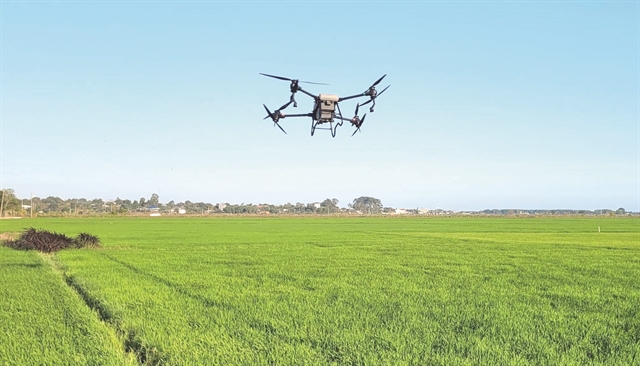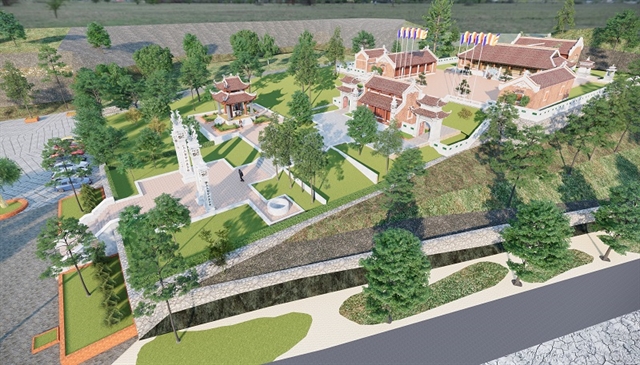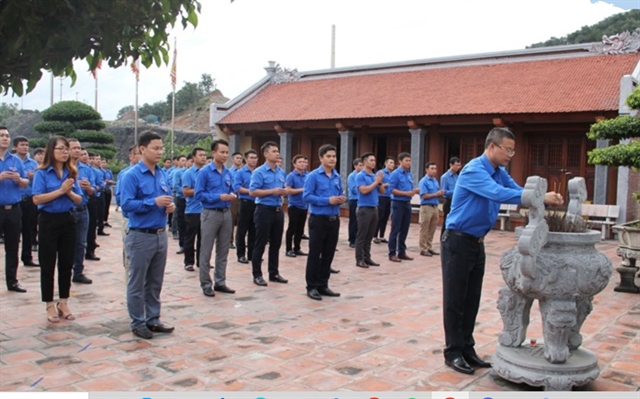 Sunday/Weekend
Sunday/Weekend

 |
| Perspective of the historical site of the first coal mining area in Việt Nam. Photo baoquangninh.vn |
Each profession has its own origins, and coal mining in the northern province of Quảng Ninh is no exception.
The Miếu Mỏ (Mining Temple) heritage site located on Yên Lãng Mountain, Yên Thọ Ward, Đông Triều Town is cited in the provincial history as a sacred place where coal was first discovered in Việt Nam, creating a foundation for coal mining to develop in the country.
 |
| The entrance gate to the Miếu Mỏ heritage site, the first Vietnamese coal mine, in Quảng Ninh Province's Đông Triều Town. Photo baoquangninh.vn |
Legend has it that a woodcutter in Yên Thọ one day went into the forest and found strange 'black stones' lying on the mountainside near a stream.
He was so amazed at the deep black colour of the stones that he decided to use them as a foundation for a cooker and started to cook rice by the stream.
Sometime later, the stones caught fire, turned red and radiated great heat.
The news around such so-called "monster stones" or "burning stones" quickly spread throughout the area until it reached a local mandarin who reported news of the stones to King Minh Mạng who then reigned in the Huế Court in the central region.
The King learned of this valuable mineral resource in the remote northern area, and requested 100 tonnes of coal to be dug up and brought to the royal capital of Huế despite it being difficult to transport at that time.
Tôn Thất Bật, a mandarin, was assigned to be directly responsible for coal mining in Đông Triều.
In December 1839, the mandarin submitted a petition to the court asking for permission to hire local people to mine the coal in Đông Triều.
 |
| A perspective of Thượng Temple in the project on preserving, restoring and promoting the Miếu Mỏ heritage site known as the first coal mine in Việt Nam. Photo minegeology.vn |
Under his direction, the plan to mine 100 tonnes of coal was completed and transported to the citadel at great speed. The King was reported to have said: "How can you force people to do such hard and unnecessary work?"
Bật replied: "As the local people are facing hardship due to losses in crops, they all volunteered to be hired for the work to get better income."
The King then agreed with the mandarin and allowed the locals to work in the mines.
If Bật was considered the first "director" of the coal mining industry in Việt Nam, then King Minh Mạng was the first "supreme leader" of the sector.
A look at both lunar and solar calendars shows that on December 6 in the 20th year of Minh Mạng era (or January 10, 1840), King Minh Mạng issued an edict to the governor of Hải Yên to exploit coal in the Yên Lãng mountain area. This edict officially established coal mining industry in the country.
Not far from Miếu Mỏ - the first coal mining site, there was also a coin minting area where local people built a temple to worship Bà Chúa Kẽm, the Goddess of Zinc.
Previously, many furnace slag and scraps were discovered by locals on the surface of the casting area. In the process of land reclamation for crop cultivation, the vestiges were cleaned up, but many of them reportedly still remain underground, with many traces left there. This suggests that along with the discovery of the "burning stones" came the development of other industries.
 |
| Vinacomin officials and workers visit the Miếu Mỏ heritage site to pay tributes to the ancestors and miners who sacrificed for the cause of coal production. Photo vinacomin.vn |
Miếu Mỏ was built of bricks but later was damaged by weather and time until coal mining workers and local people gathered to repair it as they believed in its sacredness, regarding it as bringing spiritual support for their dangerous work underground.
The construction date of the temple is unknown, but one thing that is certain from the province's historical records is that it was built when coal mining in the area began.
The temple is also a place for worshipping unknown people who went to the nearby forest to make charcoal but died without any recognition from their families.
By 2000, the temple was rebuilt on the same ground by elderly people from Yên Thọ Commune, including many retired miners.
The rebuilding was also supported by the Việt Nam Coal and Mineral Industries Group (Vinacomin). In its early days of establishment, the group decided to implement a project to restore the Miếu Mỏ relic.
It had worked with the Huế Monuments Conservation Centre to find and restore the edict of King Minh Mạng, dated January 10, 1840.
The coal industry also took this day as its traditional establishment anniversary and promoted the preparation of dossiers to submit to the government for ranking the Miếu Mỏ heritage site.
By 2008, the Quảng Ninh People's Committee recognised the site on Yên Lãng mountain as "Việt Nam's first coal mining site".
One year later, in 2009, Vinacomin carried out a project to preserve and restore the Miếu Mỏ site, spanning 40ha, along with the Bà Chúa Kẽm area of about 3.5ha, and lying about 1km from each other. The project was completed by the end of 2016.
In October 2019, a memorial house was inaugurated in honour of miners who sacrificed their lives for coal mining.
Today, Vinacomin representatives and its branch units visit the site every year on special occasions to offer incense and pay tributes to the ancestors who "gave birth" to the Vietnamese coal industry.
The visits aim to honour historical and cultural values and promote a spirit of patriotism, love and respect for those working in the coal industry.
Last year, a project was approved to broaden the area, following a decision issued in March by the Đông Triều Town's People's Committee, to take place from 2023 to 2026, according to a report from Vinacomin.
Speaking at a working session with leaders of the Quảng Ninh's coal industry in early November, Vinacomin General Director Đặng Thanh Hải emphasised the importance of the project, as it would help pass down "great traditional education values" to younger generations.
The Vinacomin leader proposed to accelerate the project's progress. He urged the investment board, consulting group and other units to complete investment procedures, site clearance, and selection of construction materials for the temple and other heritage site. VNS